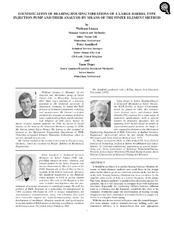| dc.contributor.other | International Pump Users Symposium (22nd : 2005) | |
| dc.creator | Lienau, Wolfram | |
| dc.creator | Sandford, Peter | |
| dc.creator | Deger, Yasar | |
| dc.date.accessioned | 2017-10-05T15:23:39Z | |
| dc.date.available | 2017-10-05T15:23:39Z | |
| dc.date.issued | 2005 | |
| dc.identifier.uri | https://hdl.handle.net/1969.1/163959 | |
| dc.description | Lecture | en |
| dc.description | pg. 1 | en |
| dc.description.abstract | It should be an objective to predict bearing housing vibrations by means of finite element methods and avoid them in the design phase rather than to go in for corrective actions on the test bed or in the field. Bearing housing vibrations due to an excitation by the impeller vanes occur, if there is a natural frequency of the pump. The finite element method is a useful tool to determine natural frequencies but it is still necessary to compare them with real tested structures. Especially the connecting stiffness between different parts in a structure and the boundary conditions has often to be estimated. Within this paper the determination of bearing housing frequencies has been undertaken systematically from a simple test device to a complete barrel pump. With the test device several influences onto the natural frequencies were studied, such as internal pressure, bolting, seals, and foundation stiffness. It is demonstrated that with appropriate modeling and assumptions the measured frequencies can be accurately met by means of finite elements. The rules observed were applied to full 3-D model of a barrel pump. The natural frequencies were determined by means of this finite element model. An experimental modal analysis was carried out on the real structure of this pump assembly. At several locations of the surface transducers were placed and the response due to the hammer test was identified in terms of frequencies and modal shapes. This result was correlated with the finite element results to update the finite element model and obtain better congruence between experiment and analysis. The results were promising, especially for the most important bearing housing natural frequency, where the differences between analysis and test were very low. This gives confidence to future analyses of bearing housing vibrations. | en |
| dc.format.medium | Electronic | en |
| dc.format.mimetype | application/pdf | |
| dc.language.iso | en | |
| dc.publisher | Texas A&M University. Turbomachinery Laboratories | |
| dc.relation.ispartof | Proceedings of the 22nd International Pump Users Symposium | en |
| dc.subject.lcsh | Pumping machinery | en |
| dc.title | Identification Of Bearing Housing Vibrations Of A Large Barrel Type Injection Pump And Their Analysis By Means Of The Finite Element Method | en |
| dc.type.genre | Presentation | en |
| dc.type.material | Text | en |
| dc.identifier.doi | https://doi.org/10.21423/R12099 | |


